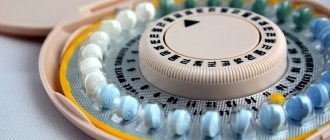Hormonal contraception is the most reliable way to protect against unplanned pregnancy. The pharmacy chain offers dozens of drugs with different concentrations and types of hormones. Among them, monophasic contraceptives are considered the most popular, since at the same time they are suitable for the treatment of certain gynecological diseases.
Contraception selection system
First of all, you need to remember that you cannot buy this type of medicine on the advice of your mother, friend or, say, sister, for whom they seem to be “well suited”. The female body has many individual characteristics, and in order to take them into account as much as possible, you need to undergo a certain medical examination before taking birth control pills.
As a rule, the gynecologist prescribes a test to determine blood sugar levels, study kidney enzymes and hormonal levels.
He also offers to undergo mammography, ultrasound of the pelvic and breast organs. It’s also a good idea to check with an ophthalmologist, because contraceptive medications can contribute to the development of eye diseases.
When selecting the necessary funds, the constitutional and biological phenotypes of the woman should also be taken into account.
They are divided into three types: estrogen, progesterone and balanced or mixed.
Contraindications
But birth control pills have their contraindications. You need to know this and strictly follow the rules for taking medications or abandon them completely.
Note!
Considering the high content of active substances in the tablets that can change the processes of ovulation, metabolism and other important events in a woman’s body, this can be harmful to health.
Women with the following diseases should not take hormonal contraceptives:
- Varicose veins with or without thrombophlebitis.
- Previous presence of myocardial infarction, cerebral infarction, infarction of other localization associated with the separation and migration of a blood clot, or acute vascular thrombosis.
- Migraine, established or migraine-like disorders of the nervous system with local symptoms.
- Women suffering from type 1 or type 2 diabetes.
- With liver diseases of both chronic origin (hepatitis, cholangitis) and acute stage.
- Diseases of the pancreas with dysfunction of the organ.
- Renal failure, both acute and chronic.
- If a woman has a malignant neoplasm, the growth and development of which is influenced by hormones.
- With any dishormonal diseases of the mammary gland or internal genital organs.
- Bleeding from the vagina, especially of unknown etiology.
- Individual intolerance to one or more components.
Estrogenic phenotype
This type includes women of average and short stature. Their chest is well developed. The skin and hair are dry, the voice is deep and feminine. Pubic hair is triangular in shape. Menstruation lasts from five days or more, causing nervousness and a tense emotional state. During this period, the mammary glands become denser.
The menstrual cycle lasts more than 28 days.
Their pregnancy proceeds virtually without symptoms, but the discharge of leucorrhoea is profuse. In general, representatives of this phenotype have fragile physical characteristics.
They are shown pharmaceutical products containing an increased amount of gestagen - Microgenon, Miniziston and Regividon.
Progesterone type
Tall women with a boyish figure and a rather deep mutational voice belong to the progesterone phenotype.
Their mammary glands are poorly developed and small in size, and their pubic hair is arranged “in a male manner” in the shape of a diamond.
Menstruation is not particularly abundant, lasting less than five days, but it is accompanied by depression, pain in the lumbar region and lower extremities.
The menstrual cycle is shorter than the traditional 28 days. Scanty discharge of leucorrhoea. During pregnancy, nausea and vomiting may occur, and significant weight gain is also possible. Hair is oily. The same type includes skin, which can have various rashes - acne, seborrhea.
It is better to focus on medications that have an antiandrogenic effect - Bepara, Klayra, Diane, Jess, Chloe, Yarina, Midiana, Janine.
Side effects
Side effects are conditions that can occur, but not in one hundred percent of cases and not all at once and not even in everyone. Therefore, you should not be afraid of this type of contraceptives just because of the side effects that even aspirin has.
- Due to a lack of zinc or iron, a condition may arise in which a woman will experience hair loss.
- Mood swings, the hormone gestagen affects the production of serotonin, so excessive tearfulness, sentimentality, or, on the contrary, depression of mood may appear. This can be treated with additional vitamin B.
- The appearance of a rash and increased production of sebum.
- Headaches, especially in nulliparous women.
- Weight gain.
- Soreness of the mammary glands.
- Painful sensations in muscles and joints. Pharmacists explain this phenomenon by the effect of estrogen on the body.
- Absence of menstruation or scanty bleeding.
- Dyspeptic disorders, nausea, perhaps even vomiting.
Mixed or balanced phenotype
Representatives of this phenotype are of average height, have a feminine voice and figure. Their chests are of medium size, but well developed. The menstrual cycle lasts 28 days, menstruation does not exceed 5 days and is virtually asymptomatic. Leucorrhoea is moderate. They tolerate pregnancy well. Hair and skin are normal. Pubic hair is arranged in a female pattern.
Most likely, Novinet, Logest, Mercilon, Lindinet - 20 and 30, Femoden, Regulon, Tri-Mercy will suit them.
When choosing contraceptive pharmaceuticals, it is also necessary to take into account age indicators.
- Thus, young nulliparous girls and mature women of late childbearing age are mainly prescribed medications from the Tri-Mercy group.
- And mini-pills, which include Exluton, Continuin, Ovret, Mikronor and Femulen, are recommended for women who have given birth, nursing mothers and more mature women.
The adaptation period to taking a new drug must be carried out under the supervision of a doctor. Only an experienced specialist can correct the situation, taking into account the entire list of symptoms that have appeared and the nature of the complaints.
Features of taking medications
Blisters with contraceptive drugs contain from 21 to 28 tablets. You should start taking it on the first day of your period, adhering to the following rules:
- It is better to place the box in a visible place so that if it catches your eye, it will remind you of the need to take pharmaceuticals daily.
- Contraceptive pills are taken at the same time.
- Having remembered the missed day, you need to immediately correct the situation, but at the same time you must use condoms during sexual intercourse during the day.
- If bleeding appears in the middle of the menstrual cycle, you should not stop taking the medication. Such symptoms are typical for the first three months of use.
- After vomiting from a birth control pill, you need to take another one.
- The day of a medical abortion is suitable for starting to take contraceptives. If this time is missed, you should wait for your period.
- Not all medications are compatible with such drugs.
Only a gynecologist can adjust the dosage options.
When choosing pharmacological agents, you need to remember that there are no bad or good drugs. There are only those that are suitable for a particular woman and those that are strictly contraindicated for her or are ineffective in her case.
Types of contraceptives
The following methods of contraception are distinguished:
- barrier;
- hormone;
- mechanical;
- chemical;
- surgical.
The most popular way to avoid pregnancy is to use a barrier method of contraception. It is based on preventing the penetration of sperm into the vagina and/or uterine cavity. Has no contraindications. Barrier agents include:
- male condoms (put on the erect penis);
- female condoms (inserted into the vagina);
- cervical caps (placed on the cervix);
- diaphragm (inserted into the vagina).
Of the described methods of barrier contraception, only male and female condoms protect against STIs (sexually transmitted infections).
Hormonal contraceptives are very effective, but they have many contraindications. They interfere with the maturation and release of eggs from the ovaries, thicken cervical mucus and thin the mucous membrane inside the uterus. If there is no ovulation, pregnancy cannot occur. If for some reason it does occur and conception occurs, then the embryo will not be able to attach to the thinned endometrium. Hormonal contraceptives include:
- tablets (taken orally daily);
- injections (a hormonal contraceptive is injected intramuscularly once every 3 months);
- subcutaneous implants (capsules are inserted under the skin to protect against unwanted pregnancy for three years);
- vaginal rings (inserted into the vagina on day 21 of each menstrual cycle);
- patch (pasted on the skin once a week, 3 times per cycle).
Hormonal contraceptives sometimes have pleasant side effects. They can reduce oily skin and prevent acne.
The mechanical method involves inserting an intrauterine device into the uterine cavity. It does not prevent conception, but it does prevent the embryo from implanting. Therefore, the IUD is not classified as a contraceptive, but as an abortifacient method of contraception. It is undesirable for nulliparous women, as well as for those who have various pathologies of the uterus. It can increase the amount of discharge and tenderness in the lower abdomen during menstruation.
The chemical method is based on the use of spermicides - substances that neutralize sperm. This method has almost no contraindications, but it is not very reliable. Chemical products include vaginal:
- pills;
- candles;
- foam;
- jelly;
- sponges soaked in spermicide.
A surgical method of contraception is based on blocking the fallopian tubes in women or the vas deferens in men. It does not affect the quality of sexual life in any way. But it has a significant drawback - it is irreversible in both women and men. Therefore, sterilization is resorted to only when there is confidence that there will never be a desire to give birth to a child again.
Table: effectiveness of various contraceptive methods
| Method of contraception | Efficiency (Pearl index) |
| Hormone | 0,15–1,5 |
| Barrier | 2–12 |
| Mechanical | 0,3–1,5 |
| Chemical | 21 |
| Surgical |
The Pearl Index shows how many women out of 100 became pregnant using this method of contraception. The lower the index, the more reliable the tool.
Video: overview of contraceptive methods
Signs of choosing the right drugs
Selecting birth control pills based on phenotype is quite simple. But since the individual characteristics of the body always make their own adjustments, for greater convincing it is necessary to take into account several important criteria.
The drug can be considered suitable if, after an adaptation period of three months, the release of blood completely stops in the middle of the menstrual cycle.
A woman’s well-being should not only return to normal over time, but also improve. According to experts, “your own” contraceptive drug can serve as a preventive measure for the formation of cysts and even benign tumors. There are also cases of improvement in the condition of the skin and hair.
Which contraceptives should girls who have not given birth choose?
The ideal option for young girls who have not given birth and are sexually active are combined oral contraceptives.
There are three types of COCs based on the amount of hormones they contain:
- Micro dosing.
- Low dosage.
- Highly dosed.
You should choose micro-containing preparations. They are perfect for those who are using this type of contraception for the first time, as they do not carry additional burden on the young body.
Note!
It may happen that micro-dose contraceptives are not suitable, then low-dose drugs should be chosen. Such drugs can not only prevent unwanted pregnancy, but also regulate the menstrual cycle.
The age of a woman who has not yet given birth and is going to take micro-dosed medications can reach twenty years or even 25 years. Until this period, a woman’s hormonal levels remain at the same level.
- Zoely;
- Claira;
- Jess;
- Dimia.











